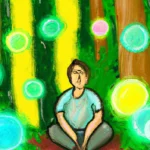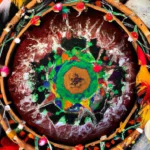As humans, we are all products of our ancestral lineage, carrying within us patterns of behaviors, beliefs, and traumas that have been passed down from generation to generation. These patterns can be both positive and negative, but when the negative ones manifest as anxiety, depression, addiction, or other mental and physical health issues, they are often referred to as ancestral wounds. The good news is that with the help of shamanic tools and techniques, we can work to heal these wounds and break the pattern of intergenerational trauma. In this article, we will explore what ancestral wounds are, how they manifest, and the various shamanic practices that can be used to heal them.
Understanding Ancestral Wounds

Ancestral wounds are unresolved issues and traumas that are passed down from generation to generation within a family or a community. They can stem from a range of experiences, such as war, displacement, oppression, abuse, and addiction. Ancestral wounds can affect individuals on a conscious and subconscious level and interfere with their ability to live fulfilling lives. They can also manifest in physical, emotional, and spiritual symptoms that may seem disconnected from their root cause. To better understand the impact of ancestral wounds, people can explore their family history and cultural background through research, conversations with relatives, and practices such as meditation and journaling. In shamanism, ancestral wounds are seen as a source of disconnection from one’s roots and a barrier to personal growth. Shamans use a variety of tools and techniques to help individuals heal their ancestral wounds and reconnect with their heritage, including journeying, soul retrieval, rituals, and plant medicine. By addressing their ancestral wounds, individuals can gain new insights into their family dynamics, cultural identity, and life purpose, and create a healthier and more meaningful life for themselves and future generations.
What are ancestral wounds?
Ancestral wounds are wounds that have been passed down from generation to generation within a family or community. These wounds can be physical, emotional, or spiritual in nature, and can have a profound impact on the lives of the individuals affected by them.
Examples of ancestral wounds include:
| Emotional trauma | Physical abuse |
| Loss of cultural identity | Systemic oppression |
| Religious persecution | Forced migration |
| War and violence | Substance abuse and addiction |
Ancestral wounds can be deeply ingrained within an individual’s psyche, even if they do not consciously realize it. These wounds can cause individuals to feel disconnected from their culture, their family, and themselves. They can manifest in a variety of ways, such as anxiety, depression, addiction, and relationship issues.
It is important to note that ancestral wounds are not limited to specific cultures or populations – they can affect anyone regardless of race, ethnicity, or gender. Healing these wounds is a crucial part of personal growth and can lead to a greater sense of freedom, self-awareness, and purpose in life.
Understanding the root causes of ancestral wounds and how they manifest is the first step in beginning the healing process. As we explore shamanic tools and techniques for healing ancestral wounds, it is essential to recognize the importance of honoring our ancestors and our ancestral heritage. It is through this acknowledgment and connection that we can begin to heal these deep-seated wounds and create a brighter future for ourselves and generations to come.
For further information on ancestral communication and connection, you can visit shamanism-ancestral-connections.
How do ancestral wounds manifest?
Ancestral wounds are often described as wounds passed down from previous generations that continue to affect individuals in the present time. These wounds can manifest in different ways and may be caused by traumatic experiences, cultural disconnection, patterns of dysfunctional behaviors, and beliefs within a family lineage. Below are some of the most common ways in which ancestral wounds manifest in our lives:
| Manifestation | Description |
|---|---|
| Repeating patterns of negative behaviors | Individuals may find themselves repeating the same negative behaviors or patterns of behavior that their ancestors exhibited. This can include patterns of addiction, abuse, or self-destructive behaviors. |
| Difficulty forming healthy relationships | Individuals who have experienced ancestral wounds may also struggle to form healthy relationships. This may be due to trust issues, fear of abandonment, or attachment trauma that has been passed down from previous generations. |
| Emotional triggers and reactivity | Individuals with ancestral wounds may find themselves reacting strongly to certain situations, even if the situation does not warrant such a response. These emotional triggers may be linked to past traumas or experiences that have been passed down from previous generations. |
| Feelings of disconnection and isolation | Ancestral wounds can also lead to feelings of disconnection and isolation, particularly if an individual has lost touch with their ancestral heritage. |
| Physical ailments and chronic illnesses | There is evidence to suggest that ancestral trauma can have physical impacts on individuals, leading to chronic illnesses and other physical ailments. |
Understanding how ancestral wounds manifest is an important step in recognizing the impact that these wounds may be having on our lives. Through shamanic techniques and tools, it is possible to heal these wounds and break free from the patterns of dysfunction that have been passed down through previous generations. If you want to learn more about how shamanism can help you heal ancestral wounds, read our article on ancestor trauma shamanism.
The impact of ancestral wounds on our lives
Ancestral wounds can have a profound impact on our lives, whether we are aware of them or not. These wounds can be passed down through generations, affecting our behavior, relationships, and even our physical health.
One of the most significant impacts of ancestral wounds is the way they shape our sense of identity and self-worth. When we carry the pain and trauma of our ancestors, we may struggle with feelings of inadequacy or unworthiness. This can manifest in a variety of ways, including self-destructive behaviors, relationship issues, and mental health problems.
Ancestral wounds can also affect our ability to form meaningful connections with others. When we are carrying the burden of our ancestors’ pain, we may find it difficult to trust and open up to others. This can hinder our personal and professional relationships and leave us feeling isolated and lonely.
In addition to these emotional and relational impacts, ancestral wounds can also have physical consequences. Research has shown that trauma can be passed down through our genes, affecting our stress responses and increasing our risk for conditions such as heart disease, diabetes, and cancer.
It’s essential to recognize the impact that ancestral wounds can have on our lives and take steps to heal them. Shamanic tools and techniques offer a powerful way to address these wounds and break the patterns of intergenerational trauma.
Related: To learn more about how shamanic practices can help us connect with our ancestors, check out our article on ancestral communication in indigenous cultures.
Shamanic Tools and Techniques for Healing Ancestral Wounds
Connecting with your ancestors through journeying is a powerful shamanic technique that can help heal ancestral wounds. This involves entering a state of deep relaxation and visualization with the help of a shamanic practitioner, who guides you on a journey to meet your ancestors and receive guidance and healing from them. Another effective technique is soul retrieval, which involves recovering lost parts of yourself that were lost due to some traumatic event experienced by your ancestors. By retrieving these lost parts, individuals can reclaim their power and strengthen their resilience. Additionally, rituals and ceremonies can help release ancestral trauma and restore balance between individuals and their ancestral lineage. Lastly, working with plant medicine such as ayahuasca or cacao can provide profound healing experiences by facilitating connections with ancestral spirits and wisdom. By utilizing these shamanic tools and techniques, individuals can begin the process of healing ancestral wounds and strengthening their connection to their heritage and culture. For more on this, read about strengthening ancestral connection through shamanic journey.
Connecting with your ancestors through journeying
is a powerful shamanic technique that can help heal ancestral wounds. Journeying involves entering an altered state of consciousness to connect with spiritual guidance and wisdom, including ancestors. Here are the steps to follow to connect with your ancestors through journeying:
- Set a positive and safe environment: It’s essential to create a safe and comfortable environment to begin your journey. You can light candles, burn sage or palo santo, and play soft music. It’s also important to set a positive intention for your journey.
- Enter the altered state of consciousness: You can use drumming, rattling, or guided meditation to enter an altered state of consciousness. This allows you to connect with the spirit world.
- Connect with your ancestors: Once you are in the altered state of consciousness, you can call in your ancestors. You can do this by setting an intention for your journey or simply asking them to come forward.
- Ask for guidance and healing: Once you have connected with your ancestors, you can ask for guidance or healing. Ask them to show you what you need to see or hear to help heal any ancestral wounds.
- Thank your ancestors: After receiving guidance or healing, it’s important to thank your ancestors. You can do this by offering them gratitude, a prayer, or a symbolic gesture such as lighting a candle or leaving an offering.
Journeying is a powerful tool for connecting with your ancestors and gaining insight into ancestral wounds. It can be a profound and transformational experience that helps you gain a deeper understanding of yourself and your lineage.
By connecting with your ancestors through journeying, you are tapping into the ancient wisdom of your lineage and honoring your shamanic heritage. This practice can help you heal from past traumas and connect with your ancestral wisdom and guidance. If you want to learn more about ancestral wisdom and shamanic healing, check out these resources: Ancestral Wisdom and Shamanic Healing, Honoring Ancestors in Shamanism, Shamanic Heritage and Lineage.
Clearing ancestral karma through soul retrieval
Clearing ancestral karma through soul retrieval is a powerful shamanic technique that involves journeying to the spirit realm to recover disconnected parts of the soul that were lost through trauma or negative ancestral patterns. This technique is based on the belief that our souls carry deep wounds and traumas from our ancestors, which can manifest as physical, emotional, mental, or spiritual issues in our present lives. By retrieving these lost parts of our soul, we can heal our ancestral karma and bring balance and harmony to our lives.
During a soul retrieval session, a shamanic practitioner enters a trance state and journeys to the spirit realm to connect with the client’s spirit guides and ancestors. They may use animal spirits, drumming, or other tools to facilitate the journey. Once in the spirit realm, the practitioner searches for and retrieves the lost soul parts that are ready to come back and be integrated into the client’s being.
The retrieved soul parts may represent lost aspects of the client’s personality, talents, or life force energy that were fragmented due to trauma, abuse, or other negative experiences. By bringing these parts back into the client’s consciousness, they can be reintegrated and the client can experience a sense of wholeness and healing.
Clearing ancestral karma through soul retrieval can also release negative patterns and beliefs that have been passed down through generations in the family lineage. The retrieved soul parts may hold the wisdom, strengths, and gifts of the ancestors, which can be reclaimed and integrated into the client’s life to bring about positive change.
It is important to note that soul retrieval is a deeply transformative process that requires preparation, intention, and integration time. The client may experience emotional release, insights, and shifts in their perception of themselves and their lineage. The practitioner may also provide additional counseling or energy work to support the client’s healing process before and after the soul retrieval session.
Clearing ancestral karma through soul retrieval can be a potent tool for healing deep wounds in the psyche and reconnecting with one’s true self and ancestral lineage. It can bring about positive change in one’s life and relationships and invite a deeper understanding of the interconnectedness of all beings.
Healing intergenerational trauma through rituals and ceremonies
Inter-generational trauma refers to the emotional and psychological wounds that are transmitted from one generation to another. This type of trauma can be caused by events such as war, genocide, colonization, slavery, and other forms of structural violence. Sadly, intergenerational trauma is a common occurrence, and many people are not even aware that they are carrying the pain of their ancestors in their bodies and minds. Fortunately, there are shamanic tools and techniques that can help individuals heal from intergenerational trauma.
One such technique is healing through rituals and ceremonies. These rituals and ceremonies are designed to create a sacred space where participants can connect with their ancestors, receive their guidance, and honor their memories. In many indigenous cultures, rituals and ceremonies are an integral part of healing, as they bring people together in a community to experience and share their pain and trauma.
One of the most common types of rituals for healing intergenerational trauma is the “ancestral healing ceremony.” In this ceremony, participants gather in a sacred space to connect with their ancestors and offer them prayers, gratitude, and love. The ceremony may involve lighting candles, burning sage or palo santo, drumming, chanting, and other ritualistic practices.
During the ancestral healing ceremony, participants are encouraged to speak out loud their intentions and prayers for healing. This can include asking for forgiveness for past wrongs, offering gratitude for the sacrifices made by their ancestors, and seeking guidance and support in their own lives. The focus of the ceremony is on releasing the pain and trauma of the past and calling on the wisdom and strength of the ancestors to help move forward.
By participating in such rituals and ceremonies, individuals can heal intergenerational trauma and restore their connection with their ancestors. They also gain a greater sense of self-awareness and purpose, as they learn to honor their past and use that knowledge to create a better future. With the help of shamanic tools and techniques like ancestral healing ceremonies, individuals can break the cycle of intergenerational trauma and create a brighter and more hopeful tomorrow.
Working with plant medicine for ancestral healing
Working with plant medicine is one of the most powerful tools for ancestral healing. Plants have been used for medicinal and spiritual purposes since ancient times, and many cultures have specific plants that are believed to have a special connection to the ancestors.
One such plant is Ayahuasca, a powerful plant medicine from the Amazon rainforest that has been used for centuries to connect with the spirit world and heal deep-seated emotional and psychological issues. Ayahuasca has a strong connection to the ancestors and is often used in ceremonies to ask for their guidance and support.
Another plant that is commonly used for ancestral healing is San Pedro cactus, which has been used for thousands of years by indigenous peoples in South America for spiritual and medicinal purposes. San Pedro is believed to have the power to heal physical, emotional, and spiritual ailments, and is often used in ancestral healing ceremonies to connect with the wisdom and guidance of the ancestors.
Other plants that are used for ancestral healing include tobacco, coca leaves, and various types of medicinal herbs. Each plant has its own unique properties and is used in different ways depending on the specific cultural traditions and beliefs of the people who use them.
Working with plant medicine for ancestral healing is an intense and transformative experience that requires careful preparation and guidance from experienced healers. It is not a one-size-fits-all approach and should only be undertaken with great respect and reverence for
Subscribe to Our Newsletter
Sign up to receive the latest news and updates.
In closing, working with plant medicine for ancestral healing is a powerful and effective way to connect with the wisdom and guidance of our ancestors and heal deep-seated emotional and psychological wounds. It is important to approach this work with great respect and reverence for the plants and the traditions that have been passed down through generations. With careful preparation and guidance, plant medicine can be a transformative tool for healing ancestral wounds and connecting with our true selves.
Benefits of Healing Ancestral Wounds
Healing ancestral wounds through shamanic tools and techniques can have a multitude of benefits, both for individuals and their communities. Increased self-awareness and self-knowledge are common outcomes of this healing work. By confronting and reconciling with the past, individuals gain a clearer understanding of their own identity and how their ancestors’ experiences have shaped them. Improved mental, emotional, and physical health is also a potential benefit of ancestral healing. By releasing negative energy and emotions that have been passed down through generations, individuals can experience greater well-being. Healing ancestral wounds can lead to a stronger connection with one’s ancestors and culture, and a greater sense of purpose and fulfillment in life. By honoring and learning from the past, individuals can feel a deeper connection to their heritage and a stronger sense of belonging.
Increased self-awareness and self-knowledge
Increased self-awareness and self-knowledge are some of the significant benefits of healing ancestral wounds through shamanic tools and techniques. When we heal our ancestral wounds, we gain a deeper understanding of ourselves and our place in the world.
Here are some of the ways in which healing ancestral wounds can lead to increased self-awareness and self-knowledge:
| Improved emotional intelligence | Healing ancestral wounds can help us become more emotionally intelligent. When we understand the root causes of our emotions and behaviors, we can better manage them. |
| Enhanced intuition | By connecting with our ancestors and working with shamanic tools, we can tap into our intuition more easily. This can help us make better decisions in all areas of our lives. |
| Clearer sense of identity | Healing ancestral wounds can help us understand ourselves more deeply by uncovering the cultural and ancestral influences that have shaped us. This can also help us embrace our unique identities and live more authentically. |
| Increase in self-esteem and self-worth | Through the process of healing ancestral wounds, we can release feelings of shame and guilt that may have been passed down through our family lineages. This can lead to a stronger sense of self-worth and increased self-esteem. |
By gaining insight into our ancestral wounds, we can heal old wounds, release negative patterns, and cultivate a stronger sense of self-awareness and self-knowledge. These benefits can impact all areas of our lives, including our relationships, our careers, and our overall well-being.
Improved mental, emotional, and physical health
Improved mental, emotional, and physical health is another major benefit of healing ancestral wounds through shamanic tools and techniques. Here are some of the ways in which this type of healing can benefit your overall health:
- Reduced Stress and Anxiety: Ancestral healing can help to release stored emotional trauma and negative energy that can lead to stress and anxiety. By letting go of these negative emotions, you can feel more calm, centered, and relaxed.
- Better Sleep: If you’re burdened by the weight of ancestral wounds, it can be difficult to get a good night’s sleep. However, by using shamanic tools and techniques to heal these wounds, you can release the negative energy and emotions that keep you awake at night and promote a better sleep cycle.
- Increased Energy: When you carry around negative energy from ancestral wounds, it can take a toll on your physical and mental health. By healing these wounds, you can release that negative energy and feel more energized throughout the day.
- Improved Relationships: Ancestral healing can help you establish healthier relationships by releasing negative patterns and emotions that may have been passed down through generations. You can build stronger bonds with family members and connect with others in a more positive way.
- Increased Self-Esteem: When we carry unresolved ancestral wounds, it can impact how we feel about ourselves, leading to low self-esteem or self-doubt. By healing these wounds, we can restore our sense of self-worth and self-love.
Healing ancestral wounds through shamanic tools and techniques can have far-reaching benefits that go beyond just healing generational trauma. By improving our mental, emotional, and physical health, we can live more fulfilling, happier lives and form deeper connections with the world around us.
Stronger connection with your ancestors and culture
A stronger connection with our ancestors and culture is one of the most important benefits of healing ancestral wounds using shamanic tools and techniques. When we heal our ancestral wounds, we gain a deeper understanding of our cultural roots and can reconnect with our ancestors in a more meaningful way.
By connecting with our ancestors, we tap into their wisdom and experience, and can learn from their successes and mistakes. This allows us to gain a greater understanding of who we are and where we come from.
With a stronger connection to our ancestors and culture, we can also experience a newfound sense of pride and belonging. This can be especially important for those who feel disconnected from their cultural heritage or have experienced cultural trauma in the past.
There are several ways to strengthen our connection to our ancestors and culture. One way is to explore our ancestral roots through genealogy research. This can provide valuable insights into our family history and cultural traditions.
Another way is to participate in cultural events and celebrations. This can be as simple as attending a cultural festival or learning to cook traditional foods.
We can also honor our ancestors through ancestral altars or rituals. This could involve setting up a space in our home to honor our ancestors with candles, pictures, and other meaningful items. We can also perform rituals to honor our ancestors, such as lighting a candle for them or leaving offerings at their gravesites.
Ultimately, a stronger connection with our ancestors and culture can bring a sense of belonging and purpose to our lives. It can help us feel more grounded and connected to the world around us. By healing our ancestral wounds, we can break free from our past and create a brighter future for ourselves and our descendants.
Greater sense of purpose and fulfillment in life
One of the most profound benefits of healing ancestral wounds is the greater sense of purpose and fulfillment in life that comes with it. Many people feel lost or unfulfilled in their lives because they are disconnected from their roots and their ancestors. By working on healing ancestral wounds, you can tap into the wisdom and guidance of your ancestors and feel more connected to your heritage. This can give your life a greater sense of purpose and meaning.
How can healing ancestral wounds lead to greater purpose and fulfillment in life?
- Clarity: Healing ancestral wounds often involves gaining clarity around your family history and the patterns that have been passed down through the generations. This can help you understand your place in your family and community, and give you a sense of direction and purpose.
- Connection: By healing ancestral wounds, you can develop a stronger connection to your ancestors and your heritage. This connection can be a source of comfort and guidance when facing challenges in life, and can give you a greater sense of belonging.
- Empowerment: Healing ancestral wounds can be an empowering process that helps you take control of your life. By breaking free from patterns of behavior that have been passed down through the generations, you can create a new path for yourself and feel more in control of your destiny.
- Fulfillment: When you feel more connected to your roots and your purpose, you are likely to feel more fulfilled in your life. You may find that your relationships improve, your work becomes more meaningful, and that you are able to pursue your passions with greater clarity and purpose.
Healing ancestral wounds is a transformative process that can lead to a greater sense of purpose and fulfillment in life. By working to heal the wounds of your ancestors, you can create a pathway for yourself that is rooted in your heritage, filled with meaning, and aligned with your true purpose in life.
Conclusion
In conclusion, healing ancestral wounds through shamanic tools and techniques can have a profound impact on our lives. By connecting with our ancestors, clearing ancestral karma, and healing intergenerational trauma, we can experience a range of benefits that can improve our overall well-being.
Through the journeying process, we can connect with our ancestors and receive guidance, wisdom, and healing. The soul retrieval process helps us reclaim lost soul fragments that contribute to ancestral wounds and clear ancestral karma. Rituals and ceremonies can help us release trauma and connect with our lineage, while plant medicine can provide additional support for our healing process.
The benefits of healing ancestral wounds are vast and can have a positive impact on our mental, emotional, and physical health. By increasing self-awareness and self-knowledge, we can better understand the root causes of our challenges and work towards lasting change. We can also develop a stronger connection with our ancestors and culture, leading to a greater sense of purpose and fulfillment in life.
It is important to remember that healing ancestral wounds is a journey, and it may take time and effort to fully address the complexities of intergenerational trauma. However, by utilizing shamanic tools and techniques, we can tap into the wisdom and healing power of our ancestors and pave the way for a brighter, more empowered future.
Frequently Asked Questions
What is the definition of ancestral wounds?
Ancestral wounds are traumatic events, negative patterns, and unresolved emotions that have been passed down through generations of a family or community.
Ancestral wounds can manifest in various ways, such as depression, anxiety, addiction, relationship problems, or physical illness.
How can I identify my ancestral wounds?
You can identify your ancestral wounds through self-reflection, family history research, and by recognizing patterns of behavior or emotional responses that seem to be repeated in your family or culture.
What is journeying in shamanic healing?
Journeying is a technique used in shamanic healing where a shaman leads a client to an altered state of consciousness in order to connect with their ancestors or spirit guides.
What is soul retrieval in shamanic healing?
Soul retrieval is a shamanic technique for healing ancestral wounds, where a shaman journeys to the spirit world to retrieve lost fragments of a client’s soul, which may have been lost due to trauma or negative experiences.
What are some rituals and ceremonies for healing ancestral wounds?
Examples of rituals and ceremonies for healing ancestral wounds include honoring ancestors through altars, ancestor veneration, or land acknowledgment ceremonies.
What plants can be used for ancestral healing?
Plants used for ancestral healing include ayahuasca, cacao, tobacco, and mugwort, among others. It’s important to work with a trained practitioner when using plant medicine.
What are the benefits of healing ancestral wounds?
Healing ancestral wounds can lead to increased self-awareness and self-knowledge, improved mental, emotional, and physical health, a stronger connection with your ancestors and culture, and a greater sense of purpose and fulfillment in life.
Can healing ancestral wounds help with physical health issues?
Yes, healing ancestral wounds can lead to improvements in physical health issues that may be related to ancestral trauma or patterns that have been passed down in a family or community.
Do I need to believe in shamanism or have a specific cultural background to benefit from healing ancestral wounds?
No, you do not need to have a specific belief system or cultural background to benefit from healing ancestral wounds. This type of healing is available to everyone, regardless of cultural background or spiritual belief.










